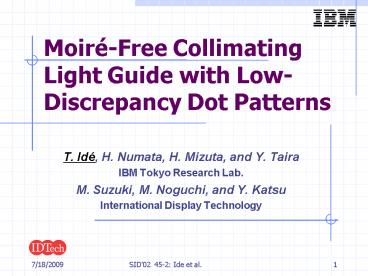MoirFree Collimating Light Guide with LowDiscrepancy Dot Patterns
1 / 21
Title:
MoirFree Collimating Light Guide with LowDiscrepancy Dot Patterns
Description:
The first attempt to apply the LDS to physical dot patterns. Need to remove inter-dot overlap... method should be used together with LDS. Our method ... –
Number of Views:119
Avg rating:3.0/5.0
Title: MoirFree Collimating Light Guide with LowDiscrepancy Dot Patterns
1
Moiré-Free Collimating Light Guide with
Low-Discrepancy Dot Patterns
- T. Idé, H. Numata, H. Mizuta, and Y. Taira
- IBM Tokyo Research Lab.
- M. Suzuki, M. Noguchi, and Y. Katsu
- International Display Technology
2
Agenda
- Background
- Why must we optimize irregular dot patterns?
- Conventional methods
- Why is a breakthrough needed?
- Our approach
- How do we generate the initial pattern?
- How do we remove inter-dot overlap?
- Implementation
- How did our approach improve the luminance
uniformity? - Summary
3
Background
- Edge-lit backlight units
- Diffusive reflection on the bottom surface of LGs
- Shape of micro-scatterers
- Distribution of micro-scatterers
- Need for higher luminance
- Restriction on physical dimension
- Restriction on power consumption
4
- A new type light guide
- Integration of a prism sheet
- Lower loss of flux
- Carefully-designed micro-scatterers
- In place of conventional diffusing white spots
- transparent
- clear moiré patterns
- optical interference LC cell micro-scatterers
Adding more diffuser films is not a good solution
5
Conventional Methods
- Simple pseudo-random number method
- The coordinates are determined directly with
pseudo-random numbers - Sufficiently irregular
- No moiré pattern
- Very rough
- Visible to the eye
- Inter-dot overlap
- Causes anomalous light scattering
6
- Pseudo-random perturbation method
- To generate patterns without inter-dot overlap
Regular lattice points
7
- Pseudo-random perturbation method
- To generate patterns without inter-dot overlap
Regular lattice points
Random perturbation
8
- Pseudo-random perturbation method
- To generate patterns without inter-dot overlap
- Known drawbacks
- Visible roughness
- Difficulties in higher density domains
- Intractable inter-dot overlap
- Survival of the periodicity
- Less flexibility
- to reproduce density distributions
9
- Summary of the conventional methods
10
Our approach
- Low-discrepancy sequences (LDS)
- Controlled homogeneity with sufficient
irregularity - Have been applied for speed-up of Monte Carlo
integration/simulations
The first attempt to apply the LDS to physical
dot patterns
Need to remove inter-dot overlap...
11
- Dynamical redistribution method
- Give each dot a repulsive force
- Small distance strong repulsion
- Large distance weak repulsion
The inter-dot overlap is removed gradually as
time evolves
- Dynamical scaling method
- The range of force varies with local density
- (range) O (minimum separation)
- The principal wavelength (Ulichney 1988)
12
- Summary of our approach
Dynamical redistribution method
LDS
Initial pattern
Final pattern
Probabilistic sampling method
Dynamical scaling method
13
- Example 1
- Steep density gradient is well reproduced
- From 10 to 50
Density distribution
Generated pattern
14
- Example 2
- Comparison of two initial patterns
- Pseudo-random and LDS
- Constant density ( 60)
15
- Example 2
- Comparison of two initial patterns
- Pseudo-random and LDS
- Constant density ( 60)
Our method
random dynamical
The dynamical redistribution method should be
used together with LDS
16
Implementation
- Integrated-type light-guide
- Experiment
- Comparison with the PRP method
- 15 inch-diagonal UXGA LC cell
17
LC cell
- A moiré pattern disappears
68mm
PRP method
(conventional)
Our method
68mm
(proposed)
Light guide
18
Summary
- Integrated-type light guide
- High luminance
- Transparent
- Tends to cause moiré patterns
- Dynamical approach with LDS
- Super-uniform
- Sufficiently irregular
- Flexible arbitrary density distributions
19
- Implementation of a moiré-free collimating light
guide - Achieved high luminance and uniformity
- Based on our new approach
- Currently the best randomization method
- IBM ThinkPad A30/A30p
- First IPS-LCD on laptop PCs
- FlexView display
- Released in Oct. 2001
Thank you!
20
Addenda
- IdealRandomizer
- Simple DLDS pattern generator
- Any density distributions
- Outputs text data file
21
- Luminance distribution
- Figure 8































